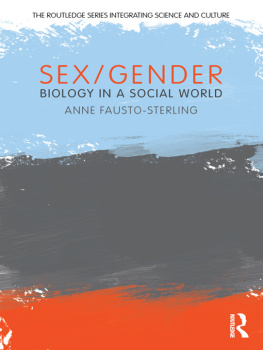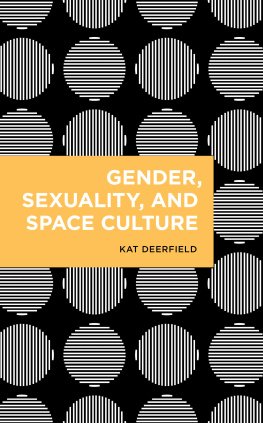All rights reserved. Printed in the United States of America. No part of this book may be reproduced in any manner whatsoever with out written permission except in the case of brief quotations embodied in critical articles and reviews. For information, address Basic Books,
10 East 53rd Street, New York, NY 100225299.
All uncredited illustrations are from the authors collection and are used with her permission.
A CIP catalog record for this title is available from the Library of Congress.
00 01 02 / 10 9 8 7 6 5 4 3 2 1
ISBN 0-465-07714-5 (paper)
eBook ISBN:9780786724338
For the ever delightful and always stimulating Paula.
You excite my heart and my mind.
PREFACE
In my previous book, Myths of Gender: Biological Theories About Women and Men (Basic Books, 1985), I exhorted scholars to examine the personal and political components of their scholarly viewpoints. Individual scientists are inclined to believe one or another claim about biology based in part on scientific evidence and in part on whether the claim confirms some aspect of life that seems personally familiar. As someone who has lived part of her life as an unabashed heterosexual, part as an unabashed lesbian, and part in transition, I am certainly open to theories of sexuality that allow for flexibility and the development of new behavior patterns, even in adulthood. I do not find it surprising, however, that someone who has always felt either heterosexual or homosexual might be more open to theories that posit a biologically determined sexuality that unfolds as one grows into adulthood.
Regardless of ones personal leanings, anyone who wants to make a general argument beyond his or her limited knowledge. must gather evidence and put it together in a way that makes sense to others. I hope I have done that well enough to convince readers of the need for theories that allow for a good deal of human variation and that integrate the analytical powers of the biological and the social into the systematic analysis of human development.
For a book written for a general audience, this volume has an unusually large notes and bibliography section. That is because, in essence, I have written two books in one: a narrative accessible to a general audience and a scholarly work intended to advance discussion and arguments within academic circles. At times the scholarly discussion can become arcane or devolve into side issues that deflect attention from the main narrative. Furthermore, academics often demand detailed evidence in the form of quotes from original sources or detailed accounts of a particular experiment. One of the ways I have used the notes is to carry on the scholarly discussions with out distracting the general reader. Although one need not do so to follow my general argument, I nevertheless urge everyone to read the notes, as they add both depth and diversity to the text.
Furthermore, Sexing the Body is a highly synthetic work, and thus most readers, be they academicians or members of a general audience, will be unfamiliar withand quite possibly skeptical ofat least some of the areas on which I touch. For this reason as well, I chose to footnote heavily, indicating that claims I make even in passing have substantial backing in the academic literature. Then, too, readers intrigued with particular topics can use the notes and bibliography as a resource for further reading of their own. This, I fear, is the teacher in me. My biggest desire in writing this book is to stimulate discussion and reading on the part of my readers, so the rich and up-to-date bibliography draws on significant literatures in fields ranging from science studies to feminism to sexuality studies to human development to systems theory and biology.
I have also included a fair amount of artwork, and again this is unusual for a book of this type. Some of the illustrations consist of cartoons or humorous drawings describing events discussed in the text. I was inspired to take this route by others who have conveyed scientific ideas using cartoons. Many people think of science as a humorless profession, and feminists are always accused of lacking a sense of humor. But this feminist scientist finds humor everywhere. I hope that some of the illustrations encourage readers suspicious of the cultures of science and of feminism to see that it is possible to be deeply serious about ones profession while maintaining a sense of humor.
Biology itself is a very visual field, as a glance at current biology textbooks reveals. Some of my illustrations, then, are intended to convey information visually, rather than verbally. In this I am merely being true to my own academic tradition. At any rate, I encourage the reader to laugh if so moved, to study diagrams if he or she wishes, or to skip over the illustrations and focus on the text, if that is the readers preferred mode.
ACKNOWLEDGMENTS
This book took more than six years to write.. During that time I have had the consistent support of family and friends who put up with my obsession and my withdrawal from polite company whenever I focused on a new deadline. I thank all of them and each of them. Each of you (and you know who you are) provide the bedrock on which I stand.
When I needed to review and synthesize material from fields outside my own, I depended on the generosity of academics and independent scholars to read drafts and let me know when I had some basic concept wrong or had left out some essential work. Each of the people in the long list that follows has a busy schedule and writing projects of his or her own, yet took the time to read and comment on early versions of one or more chapters of this book or to help me formulate some of its ideas. There are those who shared with me early versions of their own work, bringing me quickly up to date. If I have omitted anyone, I apologize in advance. Of course, these scholars bear no responsibility for the final version.
Elizabeth Adkins-Regan, Pepe Amor y Vasquez, Mary Arnold, Evan Balaban, Marc Breedlove, Laura Briggs, Bill Byne, Cheryl Chase, Adele Clarke, Donald Dewesbury, Milton Diamond, Alice Dreger, Joseph Dumit, Julia Epstein, Leslie Feinberg, Thalia Field, Cynthia Garca-Coll, GISP 006, Elizabeth Grosz, Philip Gruppuso, Evelynn Hammonds, Sandra Harding, Ann Harrington, Bernice L. Hausman, Morgan Holmes, Gail Hornstein, Ruth Hubbard, Lily Kay, Suzanne Kessler, Ursula Klein, Hannah Landecker, James McIlwain, Cindy Meyers-Seifer, Diana Miller, John Modell, Susan Oyama, Katherine Park, Mary Poovey, Karen Romer, Hilary Rose, Steven Rose, Londa Schiebinger, Chandak Sengoopta, Roger Smith, Lynn Smitley, Linda Snelling, Peter Taylor, Douglas Wahlsten, Kim Wallen.
The participants in the listserve Loveweb have shared references and reprints, have been willing to argue and disagree with me, and in the process have helped me clarify my views. Struggle, intellectual and otherwise, can be the fire that forges better ideas.













